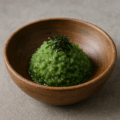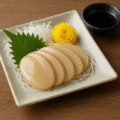天然ほやの酢の物(岩手)の特徴
夏の三陸ならではの香りを、三杯酢でさっぱりといただきます
天然のほやは、海のミネラル感と独特の香りが持ち味です。下処理をていねいにして塩水で洗い、薄切りにして三杯酢で和えると、すっきりとした旨味が引き立ちます。きゅうりやわかめ、みょうがを添えると、食感と香りに調和が生まれます。
“天然”ならではの力強い風味を生かし、薬味で整えます
養殖に比べて風味がしっかりしているため、塩水洗いと酢の力で香りを整えるのがコツです。生姜やみょうが、青じそを合わせれば、清涼感のある後味になります。
天然ほやの酢の物(岩手) レシピ
材料(5人分)
- 天然ほや(殻付き) … 4〜6個(正味約300〜350g)
- きゅうり … 1本(薄切り・塩少々で軽くもむ)
- (下処理用)塩 … 小さじ1(3%ほどの塩水を作る)
- 米酢 … 80ml
- 砂糖 … 大さじ1と1/2
- しょうゆ … 小さじ1
- だし … 大さじ2(または水)
- 塩 … 少々(味の微調整)
作り方
- 1. ほやは殻の突起(口)側を切り落として汁を抜き、縦に開いて内臓や黒い部分を除く。身を取り出し、3%ほどの塩水でやさしく洗う。
- 2. 水気をよくふき、食べやすい薄切りにする。香りを和らげたい場合は酢少量(分量外)でさっと“酢洗い”して水気を切る。
- 3. 合わせ酢を作る:米酢・砂糖・しょうゆ・だしを混ぜ、砂糖が溶けるまでよく合わせる。
- 4. きゅうりは軽く塩もみして5分置き、水気をしぼる。
- 5. ボウルにほや・きゅうりを入れ、合わせ酢で和える。味を見て塩で微調整。
- 6. 器に盛り、冷蔵で10〜20分なじませてから供する。
シェフのワンポイントアドバイス
- 下処理は塩水でやさしく洗うのが基本です。水道水のみで強く洗うと風味が逃げやすいです。
- 香りが強いと感じる天然物は、薄めに切って“酢洗い”すると食べやすくなります。
- きゅうりは塩を強く当てすぎないこと。ほやの塩味と合わせて全体がしょっぱくなりやすいです。
栄養価(1人分の目安)
- エネルギー … 60〜110 kcal
- たんぱく質 … 7〜12 g(ほや由来)
- 脂質 … 0.5〜2 g
- 炭水化物 … 6〜12 g(調味と野菜由来)
- ミネラル … ヨウ素・亜鉛など(海産物由来)
歴史
三陸の夏を告げる味として親しまれてきました
岩手沿岸では、ほやは夏の浜の味として家庭や食堂で広く親しまれてきました。新鮮な身を酢でさっぱりと仕立てる食べ方が定番です。岩手県はほやの養殖もおこなっていますが、天然物は水深20メートルから30メートルの海底に生息しており、特殊な潜水技術が必要になる事から養殖物よりも高級品となっています。
薬味と三杯酢で“海の香り”を整える知恵です
天然の力強い香りを、塩水洗いと三杯酢、みょうがや生姜の香味でほどよくまとめる所作が受け継がれ、行事や来客のもてなしにも供されてきました。
English Version
Features of Wild Sea Squirt Sunomono (Iwate)
A taste of Sanriku summer, refreshed with sanbaizu
Wild sea squirts (hoya) carry a distinct ocean-mineral aroma. With careful cleaning, a gentle saltwater rinse, and thin slicing before tossing in a light sanbaizu dressing, their clean umami shines. Sliced cucumber adds crisp contrast; optional herbs lend lift.
Bold “wild” character, balanced by aromatics
Compared with farmed hoya, wild ones are more assertive in flavor. A saltwater rinse and vinegar’s brightness help refine the aroma; ginger, myoga, or shiso can finish with a cool, refreshing note.
Wild Sea Squirt Sunomono (Iwate) – Recipe
Ingredients (Serves 5)
- Wild sea squirt (in shell) … 4–6 (net ≈ 300–350 g)
- Cucumber … 1 (thinly sliced; lightly salted)
- (For rinsing) Salt … 1 tsp (to make ~3% saltwater)
- Rice vinegar … 80 ml
- Sugar … 1½ Tbsp
- Soy sauce … 1 tsp
- Dashi … 2 Tbsp (or water)
- Salt … a pinch (final adjustment)
Directions
- 1. Trim the “mouth” tip of each hoya and drain; split lengthwise, remove innards and dark parts, and lift out the flesh. Rinse gently in ~3% saltwater.
- 2. Pat very dry; slice thinly. If the aroma is strong, give a brief vinegar rinse (extra, not from the listed amounts) and drain well.
- 3. Make the dressing: mix vinegar, sugar, soy sauce, and dashi until the sugar dissolves.
- 4. Lightly salt the cucumber, rest 5 minutes, then squeeze out moisture.
- 5. Toss hoya and cucumber with the dressing; taste and fine-tune with a pinch of salt.
- 6. Plate and chill 10–20 minutes to meld before serving.
Chef’s Tips
- Always rinse in light saltwater—vigorous rinsing under tap water can wash away delicate flavor.
- For bold wild hoya, slice thinner and use a quick vinegar rinse to soften the edge.
- Go easy when salting cucumber; combined salinity can creep up once dressed.
Nutrition (per serving, approx.)
- Energy … 60–110 kcal
- Protein … 7–12 g (from hoya)
- Fat … 0.5–2 g
- Carbohydrates … 6–12 g (from dressing & vegetables)
- Minerals … iodine, zinc, etc. (from seafood)
History
A seasonal taste that heralds Sanriku’s summer
Along the Iwate coast, hoya have long been enjoyed at home and in diners, commonly dressed as a refreshing vinegar dish when freshly landed.
Craft and value of the wild harvest
Iwate also farms hoya, but wild ones live on seabeds about 20–30 meters deep and require specialized diving to harvest; this labor makes them pricier than cultured product. The classic trio—saltwater rinse, sanbaizu, and aromatics like ginger or myoga—harmonizes their signature “sea” fragrance.



何でも質問してください!